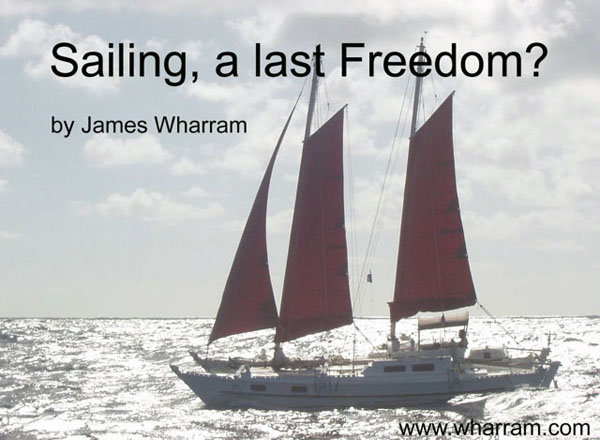
I do not know how you people feel, but when I wander around boat shows, I sometimes feel that I am in an alien world. Still, I have been sailing, coastal and around the world, for 55 years. Progressing from terrified, to bewildered, to the belief that if you trust your boat, plan ahead and get well offshore, you will survive.
For those that do not know of me, I must briefly talk about myself. 55 years ago, I should have been finishing my studies, to work with my father in a building firm and instead I ‘ran away to sea’. This sounds like a cliché, but I did it differently.
For reasons too long to go into here, for I only have 35 minutes to talk, I studied small sailing craft in libraries and museums and decided my ‘escape to the sea boat’ would be a 23’6” long double canoe, ancient sea boat of the Pacific. This type of craft at the time was declared by ‘experts’ as incapable of sailing to windward; the waves would wash across the decks and it would break up in heavy seas. Since then, I have always had scepticism about ‘experts’, even of myself.
For crew I had two German girls/ladies, who in the early 1950s were called ‘nudge, nudge’ Frauleins and had ‘Enemy Alien’ stamped on their passport.
By September 1955, we had done a 1000 miles of coastal sailing and were in Falmouth waiting for suitable weather conditions, to break out on our, and indeed Britain’s, first offshore voyage by catamaran, i.e. to sail 500 miles across the Bay of Biscay to North Spain.
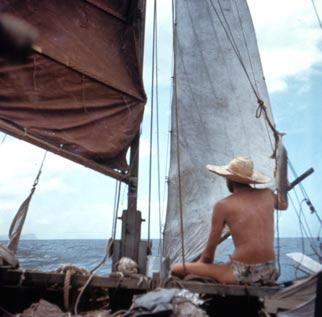
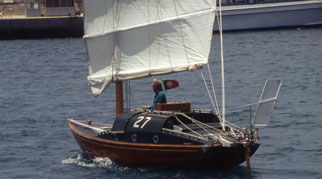
In the 1950s, indeed until the middle of the 1970s, when you sailed out of sight of land, say 20-30 miles you were alone. For the small boat sailor, there were no VHF radios, radar, GPS or other electronic instruments, never mind the mobile phone, or satellite phone and email that is the MUST of the modern cruiser/sailor. Shortwave/Ham radios needed big batteries and charging facilities few could afford. All we had was a compass, a basic watch and a small valve radio (at that time we did not yet have a sextant). One sailed close to the simplicity of Drake or the early Vikings, or indeed people of the late Stone Age.
It was at first terrifying; many people at that time, after one or two days in the lonely vastness of the ocean, gave up and sailed back to land. However, for those who adapted to the self-sufficient solitude, it was an opening of the inner spirit and a step in the direction of learning seamanship.
On our little 23’6” catamaran we survived the Bay of Biscay and went on to sail to Trinidad in the West Indies; this voyage was Britain’s first successful offshore multihull voyage. On that voyage, I learnt many things, good and bad, about myself and I became totally converted to the sailing abilities of the Stone Age concept of the double canoe/catamaran.
The 1950 sailing world was a man’s world. I learnt, during that first voyage, that sailing was very much a woman’s world. Male and female working together make an incredible supportive team. In Trinidad, with our mutual supportive team and a physical/mental boost from our friend, the now well known great French sailor Bernard Moitissier, we began, with the knowledge gained on our first voyage, to build a 40’ catamaran for Ocean sailing, with more comfort and an improved hull form for deep sea conditions.
This boat, Rongo, we sailed across the North Atlantic, a route that had never been sailed by any catamaran. This is a story I cannot discuss now due to lack of time.
In 1964, a friend, an ex-member of Popski’s Private Army said: “Jim, design me a boat like yours, to sail away.” I did, and sent a drawing of this 36’ catamaran to ‘my magazine’ ‘Yachting and Boating’ (for which I wrote a regular column), who published it. Within weeks, I was flooded with requests for designs.
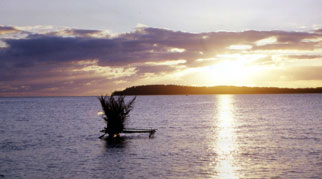
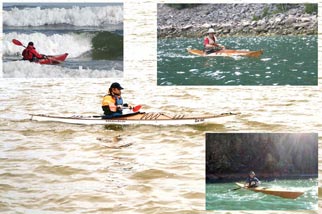
Since then, as a designer, I have never lacked people who wanted a Wharram design. By 1976, I was able to display this World Map of voyages made by Wharram catamarans at the London Boatshow. It showed that I had adapted a Stone Age vessel type for modern sailing and had successfully guided large numbers of people to build and sail them across the world’s oceans.
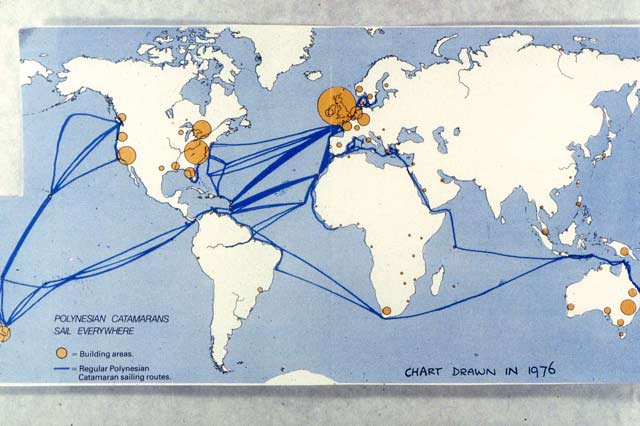
Well, that is enough about me. Now let us look at the sailing world in general.
In the present World of Sailing there are 3 different mental attitudes towards sailing:
The first and easiest to define is the Gladiatorial sailors. Like the Ancient Roman gladiators, they compete in physical and mental endurance, by challenging, in this case ‘The Sea’ and/or fellow racing competitors. A world of ‘winners’ and ‘losers’.
The second group is also easy to define. They are the people that choose their boat, like the car they drive, as a status symbol, an expression of how well they are doing financially in the world. In the Med, where I chiefly sail now, I am often invited on board the boats of such sailors. I love these invitations; the coffee and the wine are always good. Gin and tonic in abundance, a choice of Malt whiskies. Luxury has its pleasures.
I remember being invited on one such yacht (you don’t call them boats) where everything was done by electrics; sails furled, anchor raised, hot water, bath, showers, washing machine, waste compacter, electronic communications, satellite television you name it. Dazed at the display, the only comment I could make was on the excellence of the quality woodwork, I also mentioned how polished the door hinges were, they looked like gold. The answer was; “they are gold”.
I am not making any value judgments on sailing types 1 and 2. I admire some racing sailors, I equally admire some luxury yachts, but it is the third type of sailor that I belong to, which I believe is the most numerous group in the present world of sailors. How do I define this group?
Fortunately, it has been defined by Clichés. From ‘the Wind in the Willows’: “Messing around in boats”, to John Masefield: “I must go down to sea again, to the lonely sea and the sky”, or even the title of the book ‘The Magic of the Swatchways’ written by the great yachting editor Maurice Griffith.
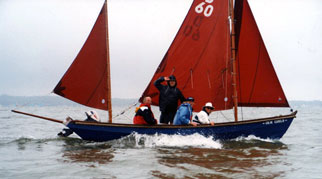
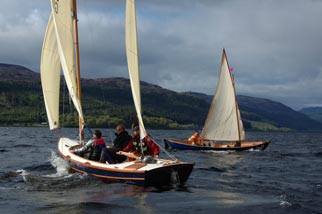
About 12 years ago, I was anchored in Madeira. A small junk-rigged 25 foot Folkboat anchored close to us, it was the Jester. Its well-known skipper Mike Richy, came over to our boat for a quick visit. After a chat and a cup of tea, he was off, a few panels of his Junkrig hoisted; off non-stop for England. No fuss, no heroics, a man alone with his small boat and the vastness of the ocean.
Over the years I have met many such sailors; single-handers, couples and small families, people who love the ocean, who love the simplicity of life that puts them very close to the inner dreams, the magic of cruising.
You do not need to cross oceans, to feel this basic magic. Last summer I was sailing our small open boat, the Tahiti Wayfarer, in the Fal estuary and Helford river. To sail a small boat around a local headland, to anchor in a wooded cove or off a sandy beach, quietly and efficiently, can give the same inner depth of feeling as crossing an ocean.
Question: Where does this innate feeling of rightness, that drives the small boat cruising sailor, come from?
Last year, Plymouth University organised a series of lectures, given by guest speakers, under the title ‘Challenging the Margins of Time’. I was one of the speakers. My topic was early man and his relationship to watercraft and the sea, with the lecture title ‘Sailing from the Unconscious’.
As you can see on this graph Homo Sapiens first emerged approx.200,000 years ago. Before him, Homo Erectus had already been around for 1.5 million years. For thousands of years modern man followed the life pattern of Homo Erectus, his tools being his hands and a shaped rock like this. One of the questions being discussed in Plymouth was, when can we date the beginning of Modern Man’s abstract thinking.
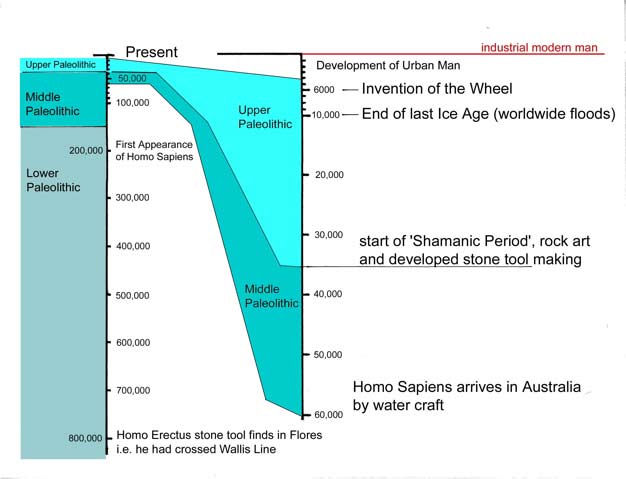
The week before mine a lecture was given by Graham Hancock, a popular writer and TV program maker. His theory was that from worldwide studies of cave painting and the emergence of sophisticated stone tools, man’s abstract thinking began about 30- 35,000 years ago.
In my lecture, I suggested that human abstract thinking must have already existed at least 50,000 years ago, when according to reliable carbon 14 dating Australia was settled by Homo Sapiens.
Until about 230 years ago, the only non-marsupial mammals in Australia were man and the dog; this shows that the sea barrier between Asia and Australia was too big for accidental drift crossings on floating vegetation. The early Australians must have arrived by directed watercraft from the then Indonesian continent, across a sea gap of at least 20 miles!
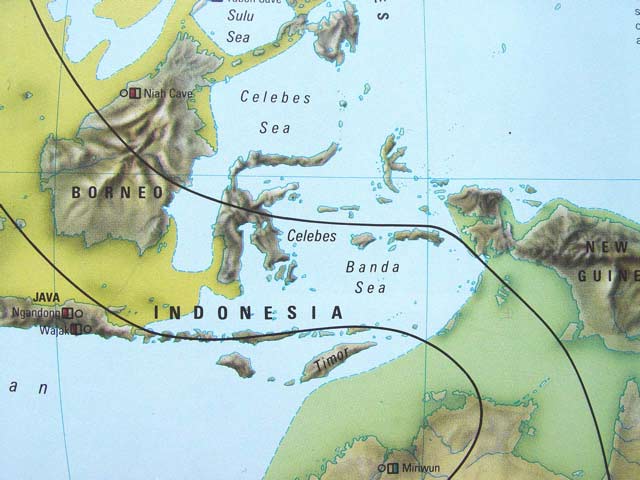
I asked the audience to imagine standing at Dover where, on a fine day, you can just discern France 21 miles away. Imagine a thick jungle behind you, a beach at your feet rich in seafood, so you are not hungry; the only tool you have is a split sharp rock and fingers that can twist fibres into twine. Think…. What kind of personal and collective thinking is required to have the concept of making a raft/watercraft and go out into that sea to explore shadows on the horizon?
Recent archaeological finds in Flores in Indonesia even suggest that Homo Erectus a very long time earlier, already must have used watercraft to reach their island home. As a result, I am coming to believe, along with other maritime archaeologists, that the use of small watercraft goes so far back in the history of our species that it is an inherited affinity. Early humans have been defined as ‘tool using primates’. It is time to redefine early man as the ‘watercraft using primate’.
I believe it is this innate affinity to watercraft that inspired me fifty years ago, and is the X-factor that drives most cruising sailors even today.
If you read the books on the development of present day cruising yachts, like Dixon Kemp’s ‘Manual on Yacht and Boat Sailing’ of 1880, or the collected writings of Albert Strange, published in the early 1900s in Yachting Monthly, Adlard Coles in the 1930s and Eric Hiscock in the 1950s and 60s and many others. Behind their stiff lipped British expressions you can see that the joys of Archaic Man’s freedom of sailing are still in the psyche of the modern cruising sailor.
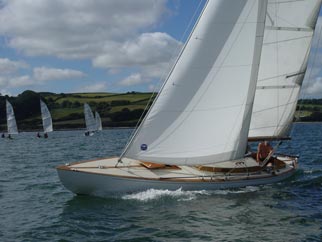
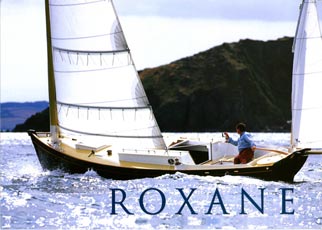
None of these writers really tell you why a modern man should spend money to get into a small boat and risk his life by sailing the seas. They give brief, but simple explanations on how to rig and sail a boat; what to do in bad weather; that navigation is a simple matter of keeping your eyes open. They make sailing seem so safe and simple. But, behind their stiff upper lip Britishness is an intriguing suggestion they have ‘seen visions’, that they have found a ‘Holy Grail’. Pleasures that only initiates feel.
Such writer/sailors inspired me and many others to become ‘Cruising Sailors’. We must never forget it is the large number of cruising sailors that enable Boatshows like this to be staged.
These small boat cruising pioneers were quite clear about what type of sailing craft could tweak these inner emotions. They are three types:
- Canoe Craft.
- Small open (trailable) boats.
- Decked small cabin cruisers, with Eric Hiscock’s 30 foot Wanderer III being a practical and leading example of a suitable boat for sailing the oceans of the World.
If you look up websites and study Yacht Magazines, you will see that we cruising sailors have never had such a wide choice of new and second hand boats.
The ‘Canoe’ in its various types; either self-built, folding, inflatable or sailing, is a fantastic economical craft. Carried in the car boot or on car roof, with low cost camping equipment, bought at a high street store, it enables you to explore the wild, lonely parts of Britain and Europe. The ‘Canoe’ in the world of cruising is an underestimated vessel type.
The second boat type, the open trailer/sailer, as in the Drascombe Lugger, has been around for many years. Designers like Phil Bolger in the US, Selway Fisher, Iain Oughtred and Swallow Boats in the UK and Francois Vivier in France have all produced small cruising trailer/sailer designs, with myself designing catamaran equivalents.
Over the last 5 years, under the concept of the ‘Raids’, a form of rowing/paddling/sailing Rally, this type of craft has become an exciting new development of an ancient watercraft concept, and has been given much publicity in magazines like Watercraft and Classic Boat.
This page from Watercraft (No. 51) shows some of the interesting ideas that are being reconsidered in yacht design. This is a simple, trailerable 17’ boat with camping accommodation that can be rowed, with easily handled rig.
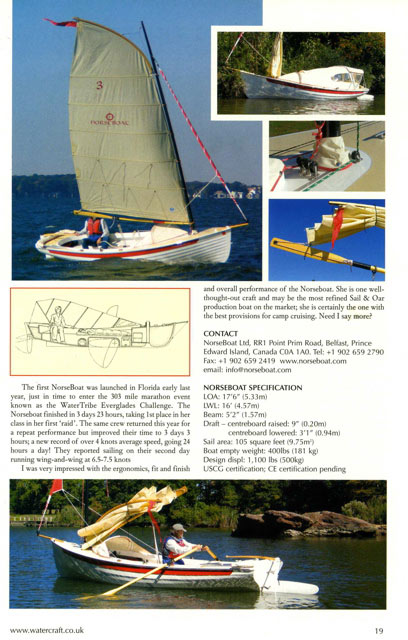
My trailer sailers are the Hitia 17 and Tiki 21, one of which sailed around the world! In fact, these small designs of mine are in recent years the most numerous (about 2000 plans sold), with many owners enjoying the simple camping cruising life. This is my Tiki 26, a design that has made several Atlantic crossings.
The third kind of craft began in the early 1900s with the designs of Albert Strange, i.e. the decked in, heavy fixed ballasted craft of 20-30ft. These are potential off-shore cruisers, but there is a major problem for many modern sailors to find moorings, and at a reasonable price. I will mention this later.
In the later 1930s the Scandinavians were producing low-cost boats similar to the Albert Strange designs, like the 26’ Tumlaren. From this design trend emerged the post-war 25ft Folkboat.
It would take hours to describe all the beautiful, seaworthy boats between 20-30ft that have been around since Albert Strange. Briefly, here are a few:
A 25ft double ended yawl from 1939, the well known 26ft Contessa, the 26ft Laurent Giles designed Vertue and the famous 30ft Vertue, Wanderer III. Many of these designs have workboat origins, like the Cornish Crabber and Pilot Cutter, this design based on a Falmouth workboat and the American Friendship Sloop.
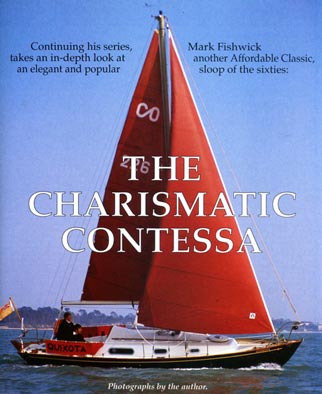
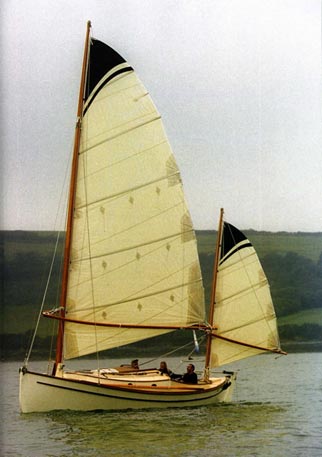
Many of these small sturdy designs have safely sailed the oceans.
But in recent years there are lighter designs on the market, for example the 30ft Roxane by Nigel Irons or this 30ft American Sharpy design by Iain Oughtred, based on the famous workboat the ‘Egret’ of the 1900s. To me they look intriguingly different. Finally my own Tiki 30 design.
Yacht magazines regularly give details of second hand craft of the types I have just shown, available at very reasonable cost. In Practical Boat Owner, December 2005 (No. 468), was a heart warming, inspirational article on one such boat by John Sagary, who made his 21ft craft (Athelon 21) unsinkable and then sailed the Atlantic aboard her.
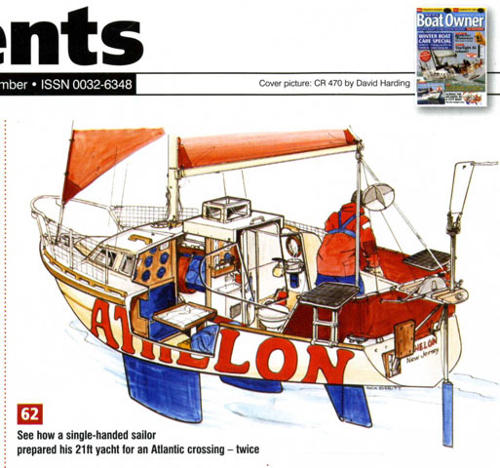
Some may think I am preaching a Hair-shirt Philosophy. I am not, I am speaking for the people who love sailing the sea, but cannot afford the modern “white” yachts, with all the added on extras, often presented as the only way to sail.
In case you think that I, as a designer, am only interested in small designs, here are some of my Ocean Cruising designs, where I have applied the same simple needs for a satisfying cruising life to simple big boats. It is then up to the owner to add extra luxuries according to his needs and financial means. The Tiki 38 is a popular family cruiser, the Pahi 63, my own boat, both simple boats suitable for simple ocean cruising. Then there are the Pahi 52 and Islander 55, which have had luxuries added for charter.
What surprised me in the last 2-3 years is the number of people who express discontent at the present day yachting scene; describing it as “too artificial”, “too expensive” “too much regulation”. There seems to be what could be described as an emotional hunger for a lost world of freedom that existed in sailing until less than 10 years ago. A boat freedom, as I have pointed out, that has existed for over 50,000 years.
Tom Cunliffe, in his Cruising Column in the latest February issue of Yachting Monthly, echoes these cruising yachtsmen’s concerns. Who do we blame for this? I suggest we start with blaming ourselves.
For example, take the high cost of mooring fees. Several years ago, Sailing Today, with the help of a barrister (Sir Patrick Sinclair BT), presented sufficient legal information to suggest that the Crown Estates, i.e. the Government, were imposing mooring fees in large areas of our sailing waters with no legal foundation. Did we, as cruising sailors support Sailing Today? Did we form committees, raise funds, lobby our Parliament? Sorry, me included, we sat on our arses and did nothing.
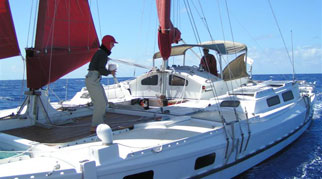
Tom Cunliffe in his February Column also mentions the RCD, the dreaded Recreational Craft Directive. Since its inception, I have been delving into the RCD regulations and writing letters about the harm it was doing to the world of the small boat cruising sailor.
Last year, under the new ‘Freedom of Information Act’ I raised the following questions: Who creates the regulations?; What is the experience of the people writing them?; How much do these people get paid for their committee work? I was curtly informed that they were not a Government body and therefore ‘the Freedom of Information Act’ was not applicable to them.
During this time magazines like Watercraft and Yachting Monthly have written scorching articles on RCD iniquities. Again, what has the general cruising sailor done to stop these RCD injustices, as shown by these magazines? Again, not enough.
Hopefully, ‘cruising man’ is now beginning to realise that his thousands of years of freedoms are under attack for the financial gain and power of others.
The title of this lecture is ‘Sailing, a last freedom?’ I have shown sailing, travelling by watercraft, was man’s first freedom, and therefore there is all the more reason for preserving it as our last freedom in a world more and more dominated by regulations.
I would now like to thank all the people that have contributed photographs to this lecture, especially Watercraft and Classic Boat magazines, from whose pages illustrations have been scanned.
- James Wharram
